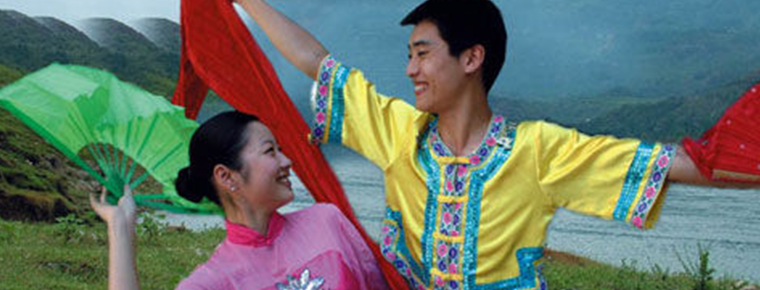Lantern Opera
Lantern Opera
Flower lantern opera is a kind of traditional opera widely popular in China. Its prominent feature is that the hands are inseparable from fans and handkerchiefs, singing and dancing, and singing and doing are closely integrated. Flower lantern opera, originating from Folk Lantern singing and dancing, is a form of local opera formed in the late Qing Dynasty and the early Republic of China. In the process of popularity, different singing and performing styles are formed due to the influence of local dialects, folk songs and customs.
Brief history of drama
Flower lantern opera is widely popular in Jiangxi, Guangxi, Zhejiang, Hunan, Hubei, Yunnan, Guizhou, Chongqing, Sichuan and Shaanxi provinces in southern China. It is a form of opera art and belongs to traditional folk minor drama. The lantern opera is developed from lantern singing and dancing, commonly known as lantern opera, flower opera and so on. The earliest record of flower lantern art is the Zhili State Chronicle of Pingyue in the early years of the Kangxi reign of the Qing Dynasty (1663). It says that "the weak boys in the city are decorated with women's clothes, group of jacquard lanterns, pretending to be tea pickers, they use lanterns as tea baskets and sing the song of"Tea Picking in December"around the courtyard everywhere. Here is Zunyi's lamp-playing custom. The custom of playing lanterns in Guiyang is found in Tian Wen's Qian Shu in Kangxi. Among them, the unknown Spring Lantern Ci has the sentences of "singing tea with a bun of flower bells" and "walking with lanterns in strings". Write about the scenes of Baina and Wumeng minorities playing lanterns during the Spring Festival in the suburbs of Guiyang. In the poem, "Tea Picking" is "Tea Picking Song in December".
The state attaches great importance to the protection of intangible cultural heritage. On May 20, 2006, lantern opera was approved by the State Council and listed in the first batch of national intangible cultural heritage list.
Inheritance significance
Since 2000, flower-lantern operas in various places have faced the same dilemma as other traditional opera arts. Theatre performances are decreasing day by day, theatre troupes are short of funds, new repertoires are difficult to arrange and perform, and the young generation of compilers and performers are short of successors. It is urgent to take measures to rescue and protect the local characteristic drama of flower-lantern opera .


-
1.Flaming Mountains
Flame Mountain in Xinjiang is the most famous scenic spot in Turpan. Located in the northern margin of Turpan Basin, the northern route of the ancient Silk Road is mainly composed of red sand
Time 2019-01-19 -
2.Kaiping Garden
Kaiping Liyuan is located in Bohua Village, Tangkou Town, Kaiping City, Guangdong Province. It is a private garden of Xie Weili, an overseas Chinese traveling to the United States in Tangkou Town
Time 2019-01-29 -
3.the Dong chorus
Originated in the Spring and Autumn Period and the Warring States Period, the Dong Grand Song has a history of more than 2500 years. It is a folk chorus form with multi-voice
Time 2019-04-27 -
4.Fuxin agate carving
Fuxin agate carving, traditional art of Fuxin County, Liaoning Province, is one of the national intangible cultural heritage.
Time 2019-04-30 -
5.Lantern Opera
Flower lantern opera is a kind of traditional opera widely popular in China. Its prominent feature is that the hands are inseparable from fans and handkerchiefs, singing and dancing
Time 2019-05-04 -
6.Kirgizyolon
The "Yolong Song" of Kirgiz is a kind of folk etiquette song spread in the Kirgiz inhabited area living in Pamir area. As a cross-ethnic, cross-cultural and cross-regional phenomenon of folk
Time 2019-05-09 -
7.Wood Watermarking Techniques
Wooden watermarking is mainly made by such basic technological procedures as hook (sub-plate), engraving (plate-making), printing (printing) and special techniques as engraving, picking and dusting.
Time 2019-06-06 -
8.ivory carving
Ivory carving refers to the carving process and its products with ivory as the material. It is an ancient Chinese traditional art, folk arts and crafts. Ivory is the strongest part of an elephant. It
Time 2019-07-06 -
9.Cao Mao
Cao Mao (241 November 15th - 260 June 2nd) Zi Yan, Pei County, Yuzhou City. Anhui Province Bozhou City People, the Three Kingdoms period the Wei state of the Three-Kingdoms Period The fourth emperors
Time 2019-09-15 -
10.China Agricultural University
China Agricultural University (China Agricultural University), referred to as "China Agricultural University", is located in Beijing City By Ministry of Education of the People's Republic of
Time 2019-12-21 -
11.Ecological environment of Luzhou
On July 5, 2019, the Ministry of ecology and environment of the people's Republic of China announced the special investigation of black and odorous water bodies in the first stage of overall planning and strengthening supervision in 2019. Luzhou was listed in the "list of cities whose
Time 2020-12-14 -
12.Suining social security
By the end of 2019, there were 23400 registered unemployed people in Suining, with the registered unemployment rate of 3.62%. 855000 people participated in the basic endowment insurance for urban employees, an increase of 114800 over the end of last year.
Time 2020-12-16